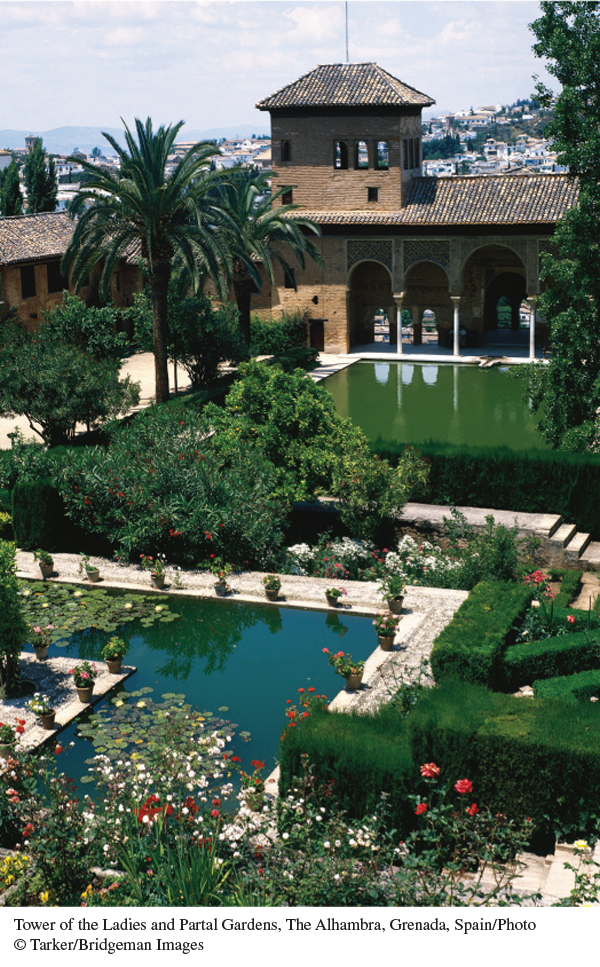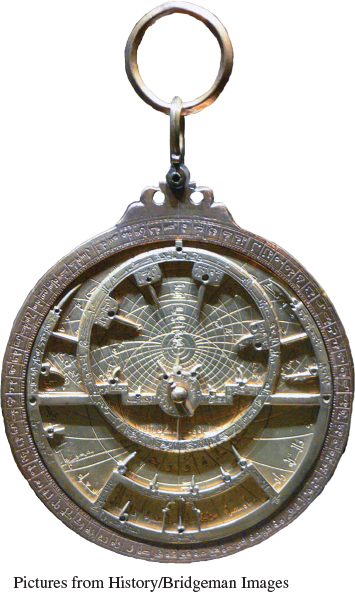A History of Western Society: Printed Page 223
A History of Western Society, Value Edition: Printed Page 211
A History of Western Society, Concise Edition: Printed Page 224
Chapter Chronology
Life in Muslim Spain
In Europe, Muslim political and cultural influence was felt most strongly in the Iberian Peninsula. In 711 a Muslim force crossed the Strait of Gibraltar and easily defeated the weak Visigothic kingdom. (See “Evaluating the Evidence 8.1: The Muslim Conquest of Spain.”) A few Christian princes supported by the Frankish rulers held out in northern mountain fortresses, but by 720 the Muslims controlled most of Spain. A member of the Umayyad Dynasty, Abd al-Rahman (r. 756–788) established a kingdom in Spain with its capital at Córdoba (KAWR-doh-buh).
Throughout the Islamic world, Muslims used the term al-Andalus to describe the part of the Iberian Peninsula under Muslim control. The name probably derives from the Arabic for “land of the Vandals,” the Germanic people who swept across Spain in the fifth century (see Chapter 7). In the eighth century al-Andalus included the entire peninsula from Gibraltar in the south to the Cantabrian Mountains in the north (see Map 8.1). Today we often use the word Andalusia (an-duh-LOO-zhuh) to refer especially to southern Spain, but eighth-century Christians throughout Europe called the peninsula “Moorish Spain” because the Muslims who invaded and conquered it were Moors — Berbers from northwest Africa.
The ethnic term Moorish can be misleading, however, because the peninsula was home to sizable numbers of Jews and Christians as well as Muslim Moors. In business transactions and in much of daily life, all peoples used the Arabic language. With Muslims, Christians, and Jews trading with and learning from one another and occasionally intermarrying, Moorish Spain and Norman Sicily (see Chapter 9) were the only distinctly pluralistic societies in medieval Europe.
Some scholars believe that the eighth and ninth centuries in Andalusia were an era of remarkable interfaith harmony. Jews in Muslim Spain were generally treated well, and Córdoba became a center of Jewish as well as Muslim learning. Many Christians adopted Arab patterns of speech and dress, gave up eating pork, and developed an appreciation for Arab music and poetry. Some Christian women of elite status chose the Muslim practice of veiling their faces in public. Records describe Muslim and Christian youths joining in celebrations and merrymaking.

Muslim Garden in Spain Tranquil gardens such as this one built by Muslim rulers in Granada represented paradise in Islamic culture, perhaps because of the religion’s desert origins. Muslim architectural styles shaped those of Christian Spain and were later taken to the New World by Spanish conquerors.
(Tower of the Ladies and Partal Gardens, The Alhambra, Grenada, Spain/Photo © Tarker/Bridgeman Images)

Astrolabe Made by al-Zarqali Abu Ishaq Ibrahim al-Zarqali (1029–1087) was an astronomer, inventor, and instrument maker who lived in Toledo, the most important center of learning in Muslim Spain. He wrote works on geography and astronomy that were later translated into Hebrew and Latin, and designed and built instruments, including sophisticated astrolabes, instruments used by astronomers, astrologers, navigators, and surveyors for locating and predicting the positions of the heavenly bodies and determining local time and latitude.
(Pictures from History/Bridgeman Images)
From the sophisticated centers of Muslim culture in Baghdad, Damascus, and Cairo, al-Andalus seemed a provincial backwater, a frontier outpost with little significance in the wider context of Islamic civilization. On the other hand, “northern barbarians,” as Muslims called the European peoples, acknowledged the splendor of Spanish culture. The Saxon nun and writer Hroswitha of Gandersheim (roz-WEETH-uh of GAHN-duhr-shighm) called the city of Córdoba “the ornament of the world.” By 950 the city had a population of about a half million, making it Europe’s largest and most prosperous city. Many residents lived in large houses and easily purchased the silks and brocades made by the city’s thousands of weavers. The streets were well paved and well lit — a sharp contrast to the dark and muddy streets of other cities in Europe — and there was an abundance of freshwater for drinking and bathing. The largest library contained four hundred thousand volumes, a vast collection, particularly when compared with the largest library in northern Europe at the Benedictine abbey of St. Gall in Switzerland, which had only six hundred books.
Page 225
In Spain, as elsewhere in the Arab world, the Muslims had an enormous impact on agricultural development. They began the cultivation of rice, sugarcane, citrus fruits, dates, figs, eggplants, carrots, and, after the eleventh century, cotton. These crops, together with new methods of field irrigation, provided the population with food products unknown in the rest of Europe. Muslims also brought technological innovations westward, including new kinds of sails and navigational instruments, as well as paper. (See “Living in the Past: Muslim Technology: Advances in Papermaking.”)

